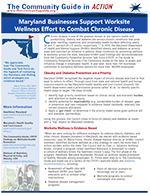Maryland Businesses Support Worksite Wellness Effort to Combat Chronic Disease
Summary
 The Maryland Department of Health and Mental Hygiene launched an initiative to decrease obesity and diabetes by promoting wellness at worksites. They used The Community Guide as a resource to assess and influence changes in employees’ health. As a result, more than 150 businesses made a commitment to workplace wellness options. (Released 2012)
The Maryland Department of Health and Mental Hygiene launched an initiative to decrease obesity and diabetes by promoting wellness at worksites. They used The Community Guide as a resource to assess and influence changes in employees’ health. As a result, more than 150 businesses made a commitment to workplace wellness options. (Released 2012)Lessons Learned
- Use the most up-to-date evidence to inform program decisions. Dr. Prince regularly visited The Community Guide website for the latest Task Force findings and recommendations, and as a result was able to apply worksite wellness interventions shortly after they were made available.
- Focus on key decision makers. The Council appealed directly to executives in various industries and companies to improve commitment to the initiative at all levels of the participating organizations.
- Gain the support of leadership by citing credible resources. The Council referenced trustworthy sources, including The Community Guide, to convince the Lt. Governor to move forward with Healthiest Maryland. In addition, data showing the potential to improve the employer’s bottom-line increased program buy-in.
Story
Obesity and Diabetes Prevention are a Priority
Maryland DHMH recognized the negative impact of chronic disease and tried to find ways to reduce its effect. Through input from state and national health and human resource experts on the Maryland Health Quality and Cost Council (Council), the health department used a prioritization process called “B.I.G.” to identify specific health areas to target. The steps include:
- Identify high-priority conditions based on clinical, social, and economic burden, with attention to health equity
- Identify potential for improvability (e.g., preventable burden of disease; gaps in prevention and care compared to evidence-based standards; relatively low current resource allocation)
- Apply a “gut check” to determine if the priority makes sense given political will and available partnerships
Using this process, the Council chose to focus on obesity and diabetes as issues with a “big” impact on Maryland residents.
Worksite Wellness is Evidence-Based
“When we were looking for different strategies [to address obesity, diabetes, and other chronic diseases prevalent in Maryland], we started with evidence-based resources,” says Dr. Maria Prince, chronic disease medical director at DHMH. Council members identified worksite wellness as a key strategy to reach the more than 3 million workers within the state. The Council and its chair, Lt. Governor Anthony Brown, initiated a program called Healthiest Maryland, a movement to create a culture of wellness where the healthiest choice is easy. The first phase of the program, Healthiest Maryland Businesses, focused on worksite-based promotion of healthy lifestyles among employees. Dr. Prince went directly to The Community Guide and made use of a variety of the Task Force’s worksite health and diabetes recommendations, including:
- Assessment of health risks with feedback (AHRF) plus health education with or without other interventions
- Diabetes disease management programs
- Point-of-decision prompts to encourage use of stairs
- Worksite programs to control overweight and obesity
With full support of key stakeholders, Council members and health department staff took the first steps to engage partners and promote worksite health programs focused on reducing obesity and diabetes among Maryland’s workforce.
Healthiest Maryland reaches out to “grasstops leaders”
“In our past worksite wellness efforts,” Dr. Prince recalls, “we realized that some of the businesses were struggling because they did not have executive level support for the programs.” Healthiest Maryland Businesses’ core strategy is to recruit and engage “grasstops leaders” the executives of Maryland’s corporations, small businesses, non-profit organizations, academic institutions, and government organizations. In addition to a signed letter of commitment stating that the chief executive believes that a healthy, productive workforce is a core part of the business strategy, Healthiest Maryland Businesses asks executives to complete an organizational assessment of health policies and practices, and of the readiness to address changes in the various areas.
Based on these data, Healthiest Maryland Businesses refers employers to organizations that can assist them in developing programs, services, or policies to address employee health risks. For example, technical assistance may include helping employers implement strategies to improve healthy food choices at work, provide access to places for physical activity, or to increase employee access to prevention services. Healthiest Maryland also connects employers with accredited wellness programs, professional organizations, and voluntary health associations that can help educate employees about individual health risks and healthy lifestyles.
Support for Healthiest Maryland
The first recruitment event for Healthiest Maryland Businesses attracted 40-50 executives to learn about the program’s process and gauge their interest. Executives heard about the potential for decreased healthcare costs, increased productivity associated with better employee health, and how that could improve their bottom-line. Within a year, more than 150 businesses, employing more than 180,000 Maryland workers, committed to the Healthiest Maryland initiative.
1 Centers for Disease Control and Prevention. U.S. Obesity Trends. www.cdc.gov/obesity/data/trends.html. Accessed on March 21, 2012.
2 Centers for Disease Control and Prevention. Press Release: Number of Americans with Diabetes Rises to Nearly 26 Million. 6 Jan 2011. www.cdc.gov/media/releases/2011/p0126_diabetes.html. Accessed on March 21, 2012.
More Information
Maryland’s Health Quality and Cost Council
Division of Nutrition, Physical Activity, and Obesity, CDC
Community Preventive Services Task Force findings referred to in this story:
The Community Guide: Task Force Findings on Diabetes Prevention and Control
The Community Guide: Task Force Findings on Obesity Prevention and Control
The Community Guide: Task Force Findings on Physical Activity
The Community Guide: Task Force Findings on Worksite Health